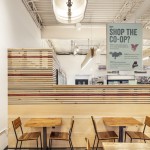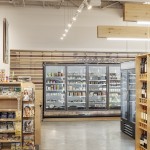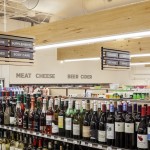Portland Food Co-op
Project Name
We worked to incorporate the values, materials and colors of the Maine agricultural experience while creating a space that feels new, clean and modern, since this is also a store located in the heart of Maine’s largest city.
The Food Co-op hopes to move from ‘Farm to Table’ to ‘Farm to Community to Table,’ where the co-op is the Community that acts as the bridge between Maine’s farms and the tables of Maine’s residents.
The project was built for a frugal construction budget of under $85 / SF not including equipment.
Total measured energy use (space conditioning, refrigeration, lighting, etc)for the last 12 months has been only 39 kWH / SF of electricity and 0.9 CCF of natural gas / SF. This equals an EUI of 228, 60% less than a typical US supermarket!
Architecture or A/E Firm Name
Architect
Team
Consultants
Location
Client
General Contractor
MEASURE 1: DESIGN & INNOVATION
The Food Co-op is the first new supermarket to be built in the heart of Portland Maine in decades. It rose out a unique community planning effort, growing from a private buyer’s club with hundreds of members to a full storefront open to the community. It is within walkable range of thousands of city residents and has a goal of selling over 50% of their goods from local farms and suppliers, a more ambitious goal than any other food store in the state.
The Co-op took over an empty strip mall storefront, bringing steady foot traffic back to a neglected building site for the first time in many years. We wanted to design a light-filled, open and welcoming storefront that a diverse population could come to rely on for healthy food.
Everything about the project was designed to encourage healthy living, for the employees working there to the customers shopping in the store. We held multiple Design Charettes to uncover the intentions, vision, look and feel of the new space that included the entire Co-op Membership as well as the design and construction team.
MEASURE 2: REGIONAL COMMUNITY DESIGN
We worked to incorporate the values, materials and colors of the Maine agricultural experience while creating a space that feels new, clean and modern, since this is also a store located in the heart of Maine’s largest city. We designed custom locally milled white pine “light beams” and white pine slat walls with stained highlights that you see throughout the store. Our goal was to bring as many natural materials as possible into the space to make it a warm and inviting environment. The boards for the space were milled only miles from the job site using local labor, skill and materials.
MEASURE 3: LAND USE & SITE ECOLOGY
The project is an urban infill site that previously housed a temporary labor office. It is now the closest supermarket to the densest neighborhood in the entire state. Before the Food Co-op opened its doors it required a car or a bus to get to all the other supermarkets in the city.
MEASURE 4: BIOCLIMATIC DESIGN
The project built a new vestibule on the exterior of the building to aid in space conditioning, to keep water, mud and snow from being tracked into the store and buffer against the harsh Maine weather.
MEASURE 5: LIGHT & AIR
We opened back up the large storefront gazing that had been obscured over the years, and placed the cafe at the front of the store to make sure that natural daylight could reach as many customers as possible. High efficiency HVAC equipment means that the shopping experience is pleasant for all.
MEASURE 6: WATER CYCLE
All the energy to make hot water in the store comes from waste heat off the refrigeration equipment, a truly innovative and rarely used technique.
MEASURE 7: ENERGY FLOWS & ENERGY FUTURE
Energy use was carefully calculated and taken into consideration in every element of the store. All hot water comes from waste refrigeration heat. The lighting is all LED and designed to 1 Watt per SF levels using custom light fixtures that integrate dimple LED linear fixtures with both down and up light components. The lighting controls are centralized and automated. All equipment motors are ECM type. Many of the coolers are refurbished units with retro lit LED lighting and have door heat controllers that sense moisture levels on the frames to carefully control condensation. The beer & meat coolers are the only new coolers, and they use Zero Energy frames to control condensation.
The measured energy use after one year is 60% less than the average US supermarket, with only 228 EUI vs 544 EUI typical.
MEASURE 8: MATERIALS & CONSTRUCTION
We concentrated on using local Maine wood at every area possible, from the light beams (1′-6″ x 25′-0″ long pine slabs!), wood slat walls, shelving units and fixtures. All the furniture in the cafe was fabricated from reclaimed wood and steel frames, for durability and sustainability. We even fabricated light fixtures for the cafe from horse watering troughs, to truly bring the Farm into the store.
MEASURE 9: LONG TERM FLEXIBILITY AND ADAPTABILITY
All fixtures and shelving can be relocated in the future on the polished concrete floor, all lighting drops from the ceiling for easy relocation, and a modern POS system was installed to allow checkout to have flexibility as payment systems change over time.




